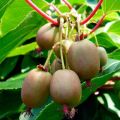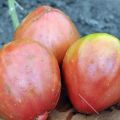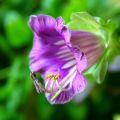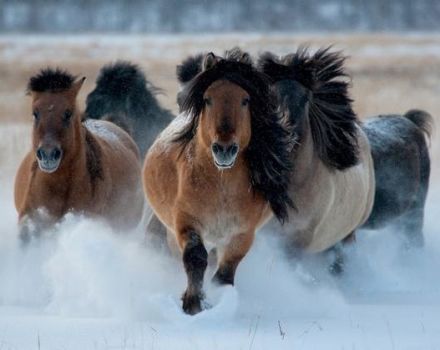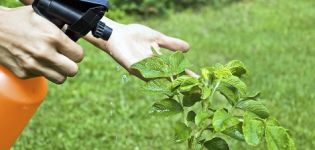Planting, growing and caring for actinidia in the open field of the Moscow region, a description of the best varieties of kiwi
Liana has a decorative look, healthy and tasty fruits. Able to decorate any site. Planting and caring for actinidia in the Moscow region is not difficult, but despite this, the plant is very rarely found in summer cottages and private plots. With the right approach, it gives a good and regular harvest, which is suitable for making jams, marmalade, preserves, marshmallows.
Content
- 1 Is it possible to grow kiwi in the Moscow region
- 2 Suitable varieties for growing and their features
- 3 How to choose quality seed and cuttings
- 4 Preparing the site and soil for planting
- 5 Landing time and rules
- 6 Seasonal care in the Moscow region
- 7 Wintering of seedlings and kiwi tree
- 8 Reproduction of vines
- 9 Flowering and fruiting period
- 10 How to stimulate fruit set
- 11 Growing problems
Is it possible to grow kiwi in the Moscow region
The plant grows well in the suburbs. If you plant it correctly and provide the necessary care, then the culture will bear fruit stably. There are several varieties of cultivars suitable for cultivation. They do not require shelter for the winter.
Suitable varieties for growing and their features
Kiwi lovers need to plant winter-hardy actinidia on their site, since the fruit grows on Chinese actinidia, which is not intended for our latitudes.
But there are better types of plants suitable for cold climates, which will delight with similar fruits.
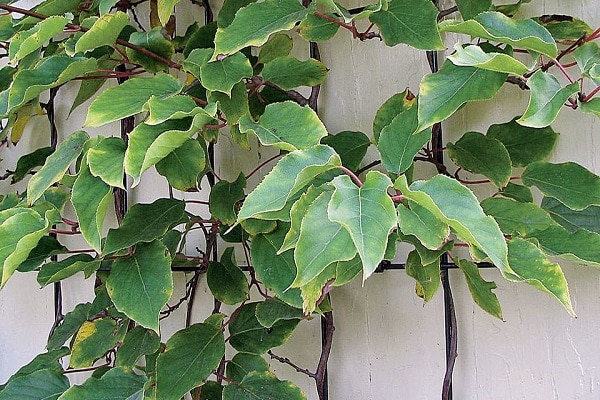
Kolomikta
Features:
- withstands cold up to -45 ° С;
- sensitive to spring frosts;
- plant height maximum 5 meters;
- trunk 10 centimeters thick;
- shoots of the plant are brownish-red;
- flowers are small, have a spicy aroma, reminiscent of a mixture of lily of the valley and lemon;
- the plant blooms in the last decade of May;
- upon reaching technical maturity, the fruits fall off.
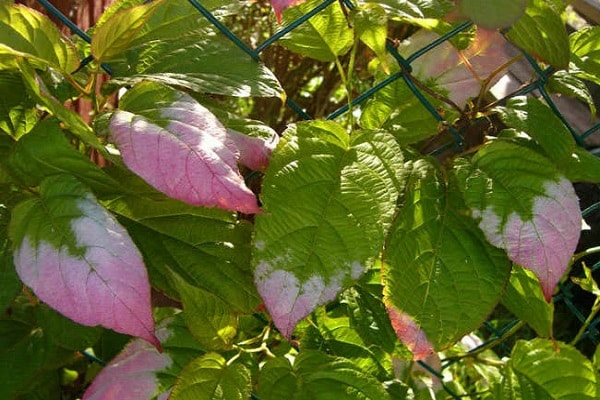
Sharp or argument
Specifications:
- reaches a height of 15 meters;
- withstands frost -40 ° С;
- the diameter of the leaves of the plant is 3 centimeters, they do not have a smell;
- the maximum yield is 15 kilograms;
- when technical maturity is reached, the fruits do not fall off.
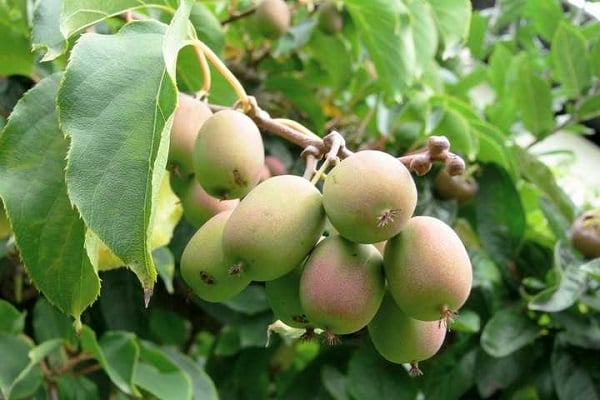
Polygamous
Features:
- height 5 meters;
- shoots are light, brown in color;
- the plant can withstand -35 ° С;
- recovers well after freezing;
- the fruit resembles a mixture of sweet peppers and figs;
- leaves 15 centimeters long.
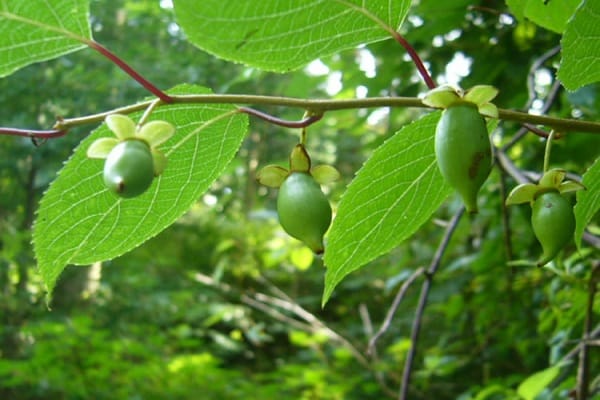
Giralda
Features:
- stems are long - 10 meters;
- the plant blooms in early June;
- ripening of fruits in September;
- harvest - 5 kilograms;
- withstands -25 ° С;
In severe winters, it requires shelter.
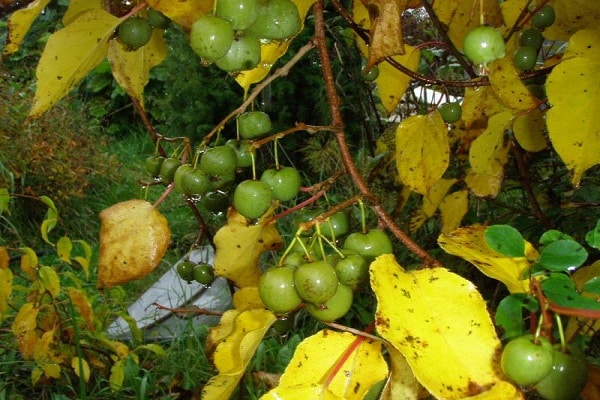
How to choose quality seed and cuttings
Seed preparation:
- The seeds are harvested in late autumn. Placed in water and incubated for 5 days. Water is renewed daily.
- Then it is wrapped in a wet cloth and buried in sand. In a humid environment, they are kept for two months. Temperature +20 ° С.
- Weekly take out, air the seeds and moisten the fabric.
- A box with sand and buried seeds is buried in the snow for 2 months. After that, they are transferred to the room, the temperature is maintained at +12 ° C.
- You will have to wait another month before germination. After that, they are transplanted into soil and grown in a room.
- When the second pair of leaves appears, you can plant it in a permanent place.
Cuttings should not be damaged, should not be dry.
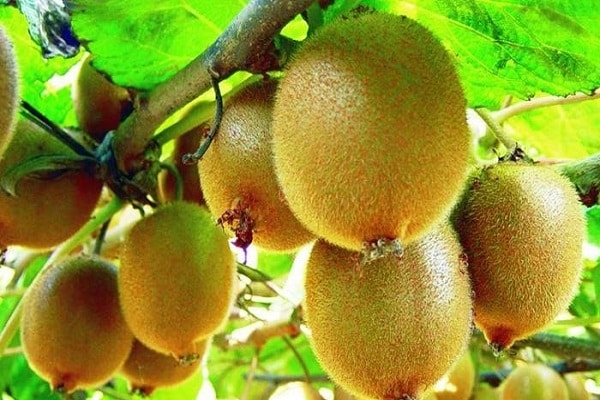
Preparing the site and soil for planting
In the country, you will need a place with a lot of lighting. In dark places, the vine is also capable of growing, but it will perform mainly a decorative function. Without enough light, the fruits practically do not grow.
The soil is chosen slightly acidic, neutral is allowed. It should be constantly moisturized, but without stagnant water.
Landing time and rules
Planted outdoors in spring. Two-year-old seedlings are best suited. With such planting material, the fruits may appear next year.
How to plant:
- Dig a hole. Depth 70 centimeters. Diameter - 50 centimeters.
- Keep a distance between plants. The ideal distance is 1.5 meters.
- Saplings of different sexes are planted. It is preferable to plant one male for three women.
- Drainage is poured into the pit.
- The seedling is kept in liquid for 1.5 hours. Placed in the hole. They are covered with soil with fertilizers. Ramp down.
- Mulch around.
- A trellis is installed nearby for support.

Cats are fans of the plant sap. To do this, they dig up the root system and injure the stems. Therefore, it is necessary to build a fence in the form of a metal mesh.
Seasonal care in the Moscow region
All varieties are looked after equally. The main thing is to follow all the recommendations.
Watering
Does not tolerate dryness and drying out of the soil. Under such conditions, it drops foliage. Because of this, young shoots can die in winter.
It is necessary to constantly keep the earth moist, but without stagnant liquid. Arrange sprinkling on especially hot days.

Top dressing
Fertilizers are applied three times per season:
- After the snow melts. Phosphate fertilizer - 20 grams, nitrogen - 35 grams, potash - 20 grams.
- When the ovaries are formed. Phosphate fertilizer - 10 grams, nitrogen - 15 grams, potash - 10 grams.
- At the end of autumn. Phosphate fertilizer - 20 grams, potash fertilizer - 20 grams.
Spread the dressing dry, slightly digging into the soil. Water immediately.
Pruning rules
The crown is formed from the third year. The procedure is carried out only in the summer. In other periods, the culture will die due to the loss of juice. Young shoots are recommended to be cut in half.
Anti-aging pruning is carried out from the age of 10.

Wintering of seedlings and kiwi tree
An adult plant does not need to be covered. Stop mulching the circle around the trunk.
It is recommended to remove young seedlings from the support and cover with spruce branches. Before covering, spray with Bordeaux liquid.
Reproduction of vines
It is not recommended to propagate by seeds. Such a plant will not produce the desired results.
Breeding is suitable:
- Layers. When the juice is finished in the shoots, they choose one. They are pressed against the soil and sprinkled with earth. The top should remain on top. Mulch around. Rooting takes place in the fall. You can not cut it until spring.
- Cuttings. Cut from strong shoots. Length 15 centimeters. The bottom cut should be oblique (45 °). The upper one is straight. At a height of 4 centimeters above the kidney. Planted obliquely into the soil. Angle 60 °. Cover with non-woven fabric. Sprayed 7 times a day. Sprinkle with leaves for the winter.

Flowering and fruiting period
The first fruits appear in the 3rd year.Stable harvest from the 7th year. Blooms in late May. Technical maturity comes unevenly. It starts in August and ends in October.
How to stimulate fruit set
To have fruits, cut off excess shoots. A culture of two sexes is planted nearby.
Growing problems
As with growing any fruit crop, gardeners are faced with some easy-to-solve problems.
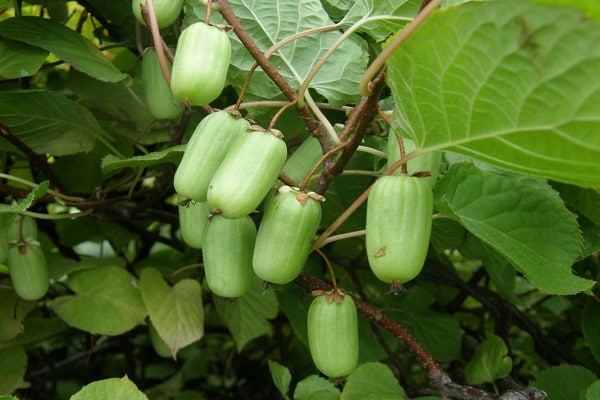
Diseases and pests
Pests are treated with insecticides. It is affected by the leaf beetle, bark beetle.
Amaze:
- leaf spot;
- fungal diseases.
For prevention, they are treated with fungicides.
Does not grow or bear fruit
The reason for the lack of fruits is the male sex of the culture:
- The plant is dioecious. They are divided into women with pistillate flowers and men with staminate flowers. Sex does not change throughout life.
- After flowering, the males fall off. Female flowers form fruits, but only under the condition of pollination, which occurs with the help of insects and air currents.
- Lianas of different sexes are planted nearby. For 2 men - 5 women.

The reasons for the lack of growth:
- The seedlings planted in the fall will not be able to take root well. As a result, in the spring they will begin to wither and die completely. It is necessary to plant only in the spring.
- In a very dark place, the plant will not want to fully develop and will lag behind in growth, so it is necessary to transplant it to a well-lit area.
- An apple tree planted nearby inhibits crop growth.
- Stagnant water can cause rotting of the root system, which will significantly affect the condition of the vine and can lead to death.
- This may be due to cats who like to feast on the plant. With constant digging in the roots, the vine slows down growth and as a result it may die.
- Young trees poorly insulated for the winter can freeze slightly. This will badly affect their condition. For some time, the vine will be stunted. If the root system is not completely frozen, growth will resume on its own after a while.
- In very hot summers, in the absence of proper watering, the plant can slow down growth. If you do not urgently correct the situation, the vine will drop all the foliage. The soil must be constantly moist. To reduce the amount of watering, the land around the plants is mulched.
To improve growth, it is recommended to plant hazel and currant. Plants nourish the vine, thereby improving its performance.


